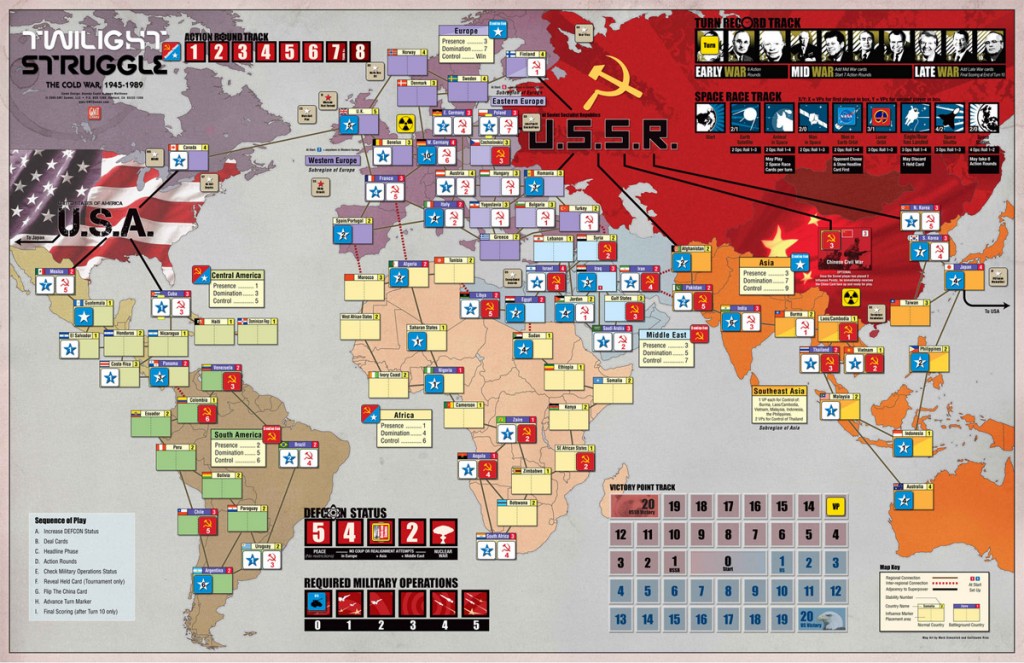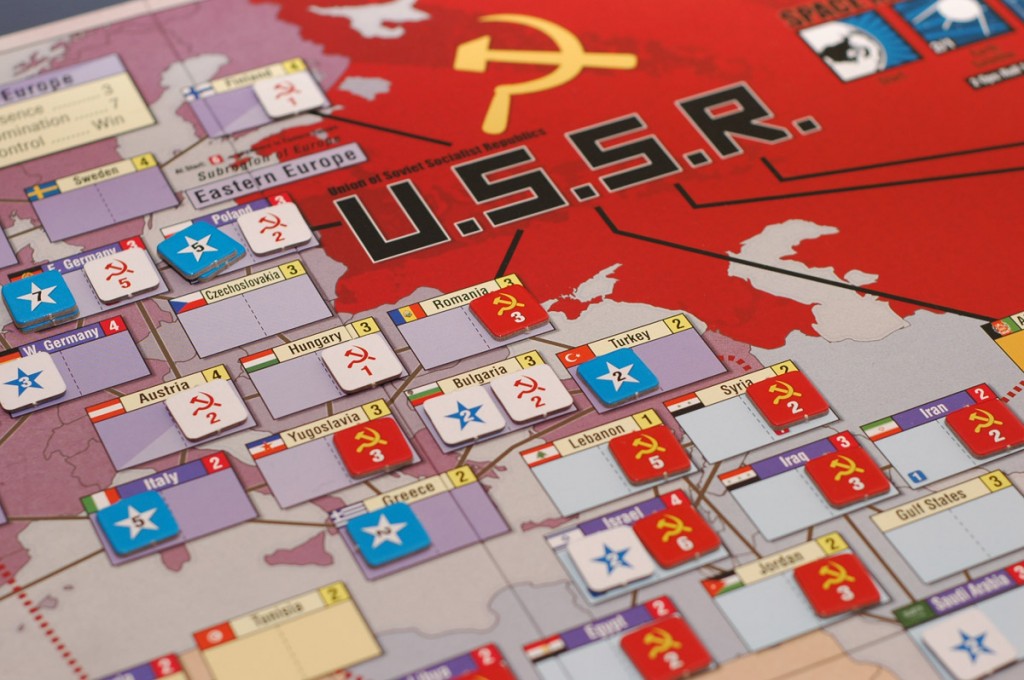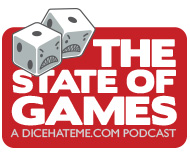Baby, It’s Cold Outside – A Twilight Struggle Review
“Russians don’t take a dump, son, without a plan.” – Admiral Painter, The Hunt For Red October
 A funny thing happened in the world of board gaming on Dec. 9, 2010; the top-ranked game for the better part of 7 years running on BoardGameGeek was usurped by a very unlikely candidate – Twilight Struggle, a massively strategic, chit-laden, brain-grinding, two-player game about the Cold War, released in 2005. Huh. And this is why I love the board gaming community. This is also why, four hours after learning the news, I walked out of my favorite local game store with Twilight Struggle under my arms and my wife and I proceeded to get about 4 hours sleep over the next five days.
A funny thing happened in the world of board gaming on Dec. 9, 2010; the top-ranked game for the better part of 7 years running on BoardGameGeek was usurped by a very unlikely candidate – Twilight Struggle, a massively strategic, chit-laden, brain-grinding, two-player game about the Cold War, released in 2005. Huh. And this is why I love the board gaming community. This is also why, four hours after learning the news, I walked out of my favorite local game store with Twilight Struggle under my arms and my wife and I proceeded to get about 4 hours sleep over the next five days.
Upon opening the heavily-compacted box, we discovered that there were about 1,687,241 little cardboard chits, divided amongst two cardboard sheets. While the wife practiced her chit-punching skills, I dove into the rulebook. The instructions read like the missile codes for silo 237 near Tribune, Kansas, or the operations manual for a 1968 Dodge Dart. There were numbers everywhere, and every single line in the rulebook is coded so that rules earlier or later in the rulebook can use this code for cross-referencing. It’s all a bit reminiscent of a large-print Bible or the 8 volume statute laws for housing in Brooklyn, and can be a bit intimidating. Luckily, this was not my first “war” game, and so the concepts were far from alien.
After about an hour of surveying the territory and going over the rules for the third time, the wife took on the side of the free world, while I readied the Red Tide. After that first game, I was tempted to call the game Twilight Imperium Struggle because of its length. That first game took us almost 3 hours, and we only made it to round 5. Things seemingly got better when our second game ended at round 6 and it only took us 1.5 hours. Of course, that’s when we realized that we had missed rule 23.1.10.z.5x.B that made the game much, much more complex.
Despite the thickish, cross-indexed rulebook, the underlying gameplay and concepts of Twilight Struggle are fairly simple. The period of play begins at the end of World War II, as Germany is split between Soviet and US occupation; the two players of the game assume the roles of these burgeoning superpowers. The game is broken into ten rounds, each representing a particular span of time in the Cold War, ending in 1989. The goal of the game is to spread enough influence throughout the world to become the reigning superpower by the end of round 10.
OPERATIONS
Each player spreads influence and affects their standings in the world through play of cards that are received each round. Every card contains a starred number, the color of which indicates which side benefits from the event listed on the card, should that event be activated. The number represents how many Operations (Ops) Points that card provides the player when the card is put into play. These Operation Points can be used in various ways to try and control a country and therefore score more points in that region when the region is scored.
Operation Points may be used in the following ways:
- INFLUENCE. Ops Points are used to Influence a country for control. If a country contains no influence of another superpower, then the player may place one Influence Point per Ops Point spent. When that player has an equal or greater amount of Influence than the country’s Stability score, then that player controls the country. When a country is controlled by another superpower, cost of another player placing influence there is doubled.
- REALIGNMENT ROLLS. These high risk, high yield rolls are used to reduce the amount of Influence an opponent has in a country while raising the player’s own. The risk is that, with a bad die roll, the opponent may gain more Influence there than was present previously.
- COUPS. In a coup, a player uses Ops Points to boost a die roll in an effort to use military force to take control of a country. The outcome of a coup is more easily controlled than a realignment roll, but attempting coups on “battleground” countries will cause the Defcon level to drop. When the world hits Defcon 1, nuclear war breaks out and everybody loses. This is, of course, a very bad thing.
EVENTS
Each card, with the exception of Scoring cards, is also playable as an Event. If the color of the numbered star matches the player’s superpower – blue for the US and red for the USSR – then that player may opt to activate the event associated with the card, instead of using the number inside the star as Ops Points. When played, the effect on the game is thematically tied to the event, creating not only a reason for the event, but also a close tie to the overall theme. For instance, the Fidel card allows the Soviet player to take control of Cuba. This card is an Early War card, which means that it comes into play within the first three rounds of the game.
If a card displays a numbered star with a color opposite of the player’s superpower, then that Event is activated if the player uses the card for Ops Points. The good news is that the player receives some Ops Points – the bad news is that your opponent is going to get a nifty little bonus with which you’ll have to contend.
SCORING
Mixed in amongst the Event cards are certain Scoring cards which, when played, force players to tally up controlled countries in a certain region and determine scores. Typically, players will have one or two cards left over each round that they can hold in their hands to the next round, hoping to make a big play or minimize the effects of a particularly nasty Event that will benefit their opponents. Scoring cards cannot be held from round to round; all Scoring cards must be played before the end of the round, even if that means holding onto cards that may help a player to gain more Influence.
STRATEGY
Twilight Struggle is all about balance – how best to keep your Influence spreading in the world while containing your opponent’s Influence, matching lost Scoring opportunities, minimizing the effects of detrimental Events, and figuring out the right mix of long-term strategy with immediate tactical play. Here are a few key points that are essential for solid play in Twilight Struggle:
- EVENT MANAGEMENT. Each player will typically find a healthy mix of both red and blue cards in their hand each round, so it is essential to calculate when to play a card that will trigger an Event that is detrimental to your superpower and then diffusing the effects of that card through clever use of Ops Points.
- THE SPACE RACE. Each superpower can discard card(s) of a certain Ops Point value to try to advance in the Space Race each round. By advancing, the player can gain both victory points and/or special abilities, as well as get rid of a card that would trigger a particularly nasty opponent’s Event.
- PATIENCE AND DILIGENCE. This game is mostly a struggle for the US player. US players must not get discouraged. Just like in the real Cold War, the Americans are up against a Red Tide and they have to stick it out for the long war. My wife and I have played Twilight Struggle over eight times now, and each time the US has lost to the Soviets; however, each time the strategy of the US become clearer and clearer. It is very important for the US player to make wise tactical decisions in the early game to contain the Soviets, then focus on their long-term plans for scoring around mid-game as the mix of helpful US Events will begin to outweigh the strong Soviet Events from the Early War. The last game my wife and I played I managed to take the US all the way until the final round and then eventually lost in final scoring because of a tactical error in Europe in round 8. Had I stayed completely focused on controlling Europe, I likely would have celebrated as the Berlin Wall fell.
Overall, Twilight Struggle can be a grueling, grinding experience, but the end rewards are rich. Rarely have I played a game more balanced in strategy and tactics, where every decision is crucial. The mechanics of the game are incredibly tight, which, when combined with abilities and historical flavor of the cards, can create a truly immersive experience.
One of the game’s amazing qualities is how well the cards and the situations around the board can recreate history; at one point, my wife and I spent almost an entire round fighting a long, prolonged struggle for influence over Cuba while the Cuban Missile Crisis loomed. In a later game, we fought vehemently for control of East Germany at about the time that Reagan asked for Gorbachev to tear the wall down. It is this attention to detail and the resulting gameplay which makes you feel as though you are not only living history, but influencing it, that makes Twilight Struggle transcend the ordinary and chronicle this extraordinary period of the 20th century all in the placement of a single chit and the smooth roll of a die.
| Gameplay/Replay | Components & Theme | Fun |
|---|---|---|
| Overall score: 17 out of 18 - Definitely not for the timid, but huge rewards for the bold and the brave. | ||
Twilight Struggle is a game for 2 comrades, preferably old enough to at least know what the Cold War is all about, from GMT Games. It retails for $49.95 (but ask your favorite local game store for a holiday deal).
Related posts:
- Cold War: CIA vs KGB – Dosvidanya Boredom
- Races of Twilight Imperium
- Pub Play: Cathedral
- DiXit:The Cure for the Common Party (Game)
- Alien Frontiers: The Best of All Worlds
Comments
19 Responses to “Baby, It’s Cold Outside – A Twilight Struggle Review”Trackbacks
Check out what others are saying...-
[…] This post was mentioned on Twitter by Chris K., Chris K.. Chris K. said: Ready for the most intense Dice Hate Me review to date? Get comfy, pour some cocoa – it's time for Twilight Struggle! http://bit.ly/hISPIJ […]
-
[…] It? If you like the theme of the Cold War but you’re not quite ready to sink a few hours into Twilight Struggle, this is a shorter, simpler game that lets you play a world superpower. With the streamlined game […]
-
[…] It? If you like the theme of the Cold War but you’re not quite ready to sink a few hours into Twilight Struggle, this is a shorter, simpler game that lets you play a world superpower. With the streamlined game […]
-
[…] The gist of the game is thus: the two players are rulers of rival factions/kingdoms/governments. Each wants to find the other faction’s leader and assassinate him, or use influence to turn the people against their ruler in a coup. Hrm, influence, coup, rival governments… sounds like the unintentional December Cold War theme at Dice Hate Me has popped up again! […]
-
[…] OF HEROES: AWAKENING THE BEAR! After my wife passed the hardcore test that is Twilight Struggle and loved it, I’m thinking it might be time to introduce her to beginner grognard […]
-
[…] Twilight Struggle […]
-
[…] a few times in the family parlor. For prime examples of “gamer’s games,” see: Troyes, Twilight Struggle, Puerto Rico; do not see: Clue, Settlers of Catan, Ticket to Ride. Designer Louis Perrochon, and a […]
-
[…] Twilight Struggle (2-player only, thinky, area Control, history, wargame, dice uniqueness, travel) […]
-
[…] Here's probably the best review of Twilight Struggle I've seen: Baby, It’s Cold Outside – A Twilight Struggle Review | Dice Hate Me This is Twilight Struggle's 2 hour brother: 1960: The Making of the President | Board Game | […]





So, it makes me a little sad that you reviewed this one, as it was the next one on my list to write a review for. ; ) Oh well, I guess I’ll write some others and come back to this one later. Overall, though, I agree – this is an awesome game and incredibly intense. It also looks like you got a later printing than me, too, which is good because in the earlier printings the game map wasn’t matted – it was just cardstock and so it didn’t lay flat very well.
Haha, I’m sorry! I didn’t mean to steal any thunder. I hope you do review Twilight Struggle – I enjoy seeing others’ perspectives on awesome games that I enjoy playing.
I did get the latest possible version of the game, and the board is superb. I had heard some grumblings about the previous boards – I think that it would drive me insane to play it on cardstock that won’t lay flat. It would be a nightmare with all those chits!
Yeah, it is. We normally wind up having to put phones and stuff on the board to help it lay flat. I’ll review it in a couple weeks, probably, so that we’re not posting the same game at the same time, and when I do, you’ll be able to see all the phones and iPods sitting on the board to help it lay flat. Fortunately, after we took care of that, the game was totally worth it!
I must agree with you, its a genius game and one of my wife’s favourites. The real genius for me is the fact it creates the essence of the cold war, if you don’t strike back when struck, you lose. It’s a classic game of tit for tat and the winner will be the person who rises to the correct tits and avoids the right tats.
I absolutely love this game and will China Card anyone who says otherwise!
Thanks so much for giving my favorite game a glowing review. Very well-written.
P.S. Realign rolls never add influence to the target country, but they can reduce your own if you attempt it in a country where you have influence.
Bradford – I’m glad you enjoyed the review – thanks for commenting. And yeah, about the realignment rolls, I’ve been meaning to clarify that in the article. My wording is definitely muddled. Thanks for the heads up!
I have the original Twilight Struggle with the paper map. What we have done here is buy from Wal-mart, K-mart, other marts poster frames that are 36 X 24. Most games can’t afford hard board maps, so have paper maps but if you slip them into the poster frames they are protected by plexiglass and lay flat. These have run anywhere between 10.99 and 20 or so bucks. There is also a company that sells card protectors. card protectors in the 36×24 size will protect the game. I think they cost 8.95 each. I have one. I unfortunately don’t have the link for the card protector company as and other club member did the order. If I dig I guess I can find it.
TWS has gone through 3 printings and you have the 3rd (and hopefully the best). GMT made it a deluxe copy, and also fixed some of the rules questions. But the 1st and 2nd editions have paper boards and play almost as well with the poster board
Bill- Thanks for stopping by. Those are good tips for anyone who doesn’t have the deluxe edition, or might play other games that have paper maps. I don’t have many of those types of games in my library, so I wouldn’t have known the poster frame trick. I’m not sure I would mind playing a game like this with a paper map, as long as I could keep it flat – but the cardboard mount sure is nice!
What a fantastic review! It must be the best board game for two players out there that I can think of. I reviewed twilight struggle also, it toppled settlers of catan (with cities and knights expansion) as my favourite when I discovered it.
Matt – Thanks! Yeah, Twilight Struggle is amazing, and worth every bit of praise that it receives. A real triumph in boardgaming.